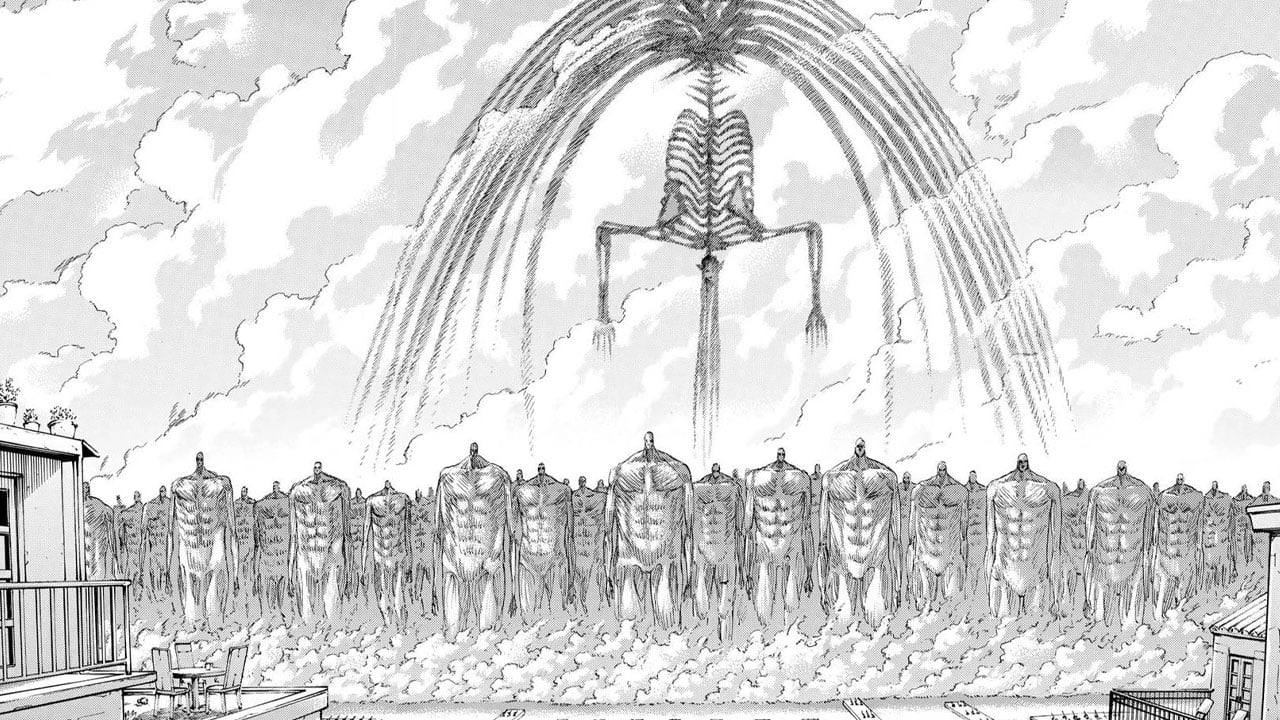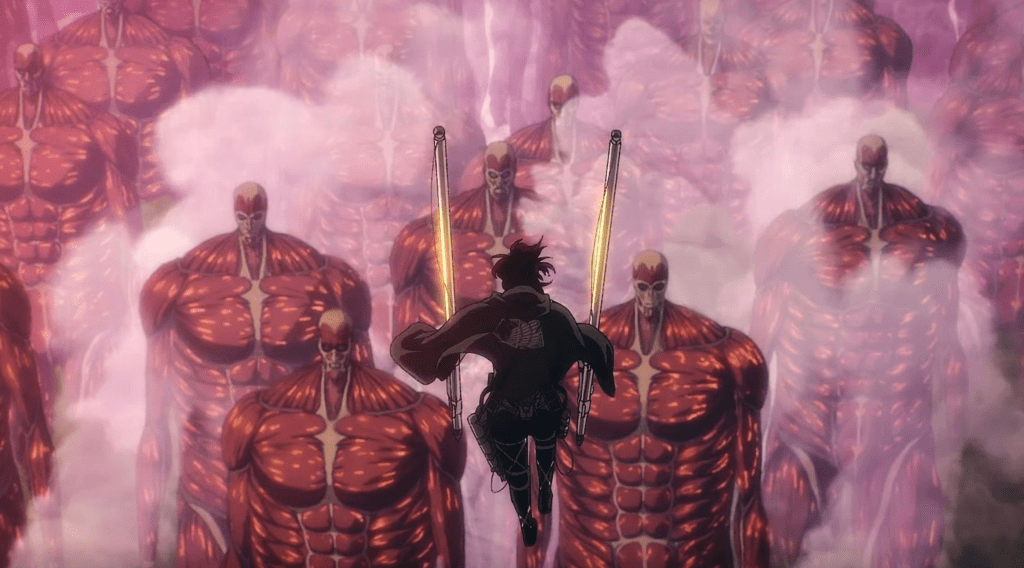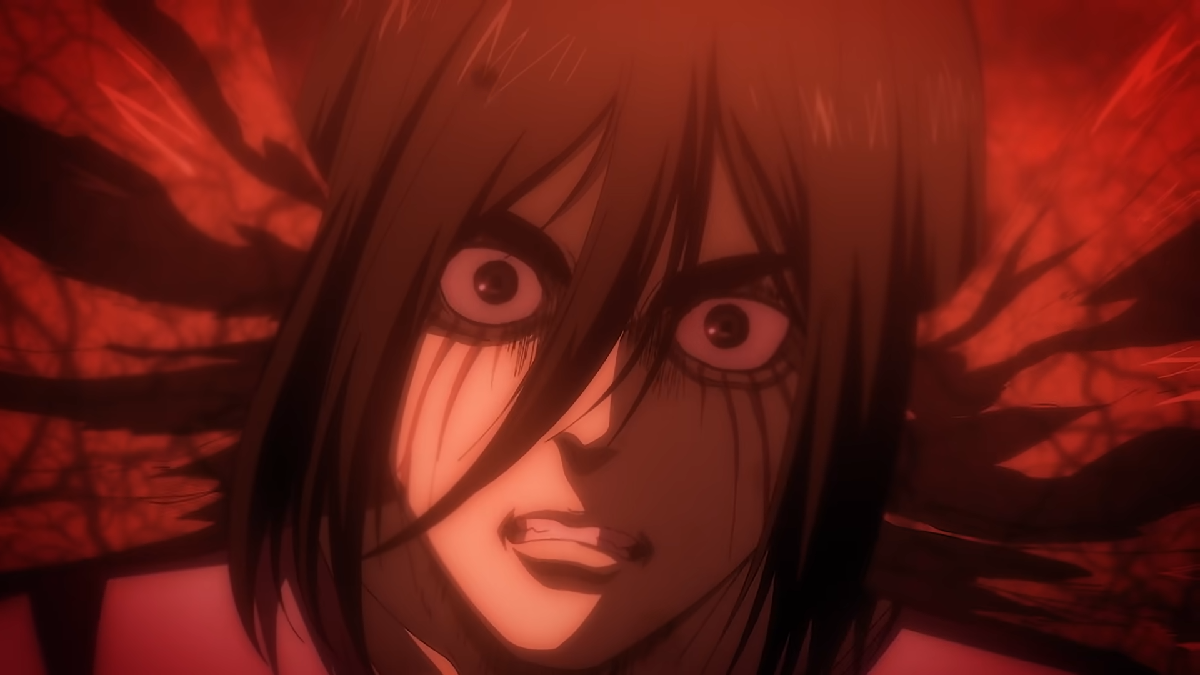The Rumbling is one of the most pivotal and devastating events in the Attack on Titan series. It represents a turning point not only for the story but also for the characters, particularly Eren Yeager. The concept of the Rumbling revolves around unleashing the Titans encased within the walls, and its primary purpose is to annihilate all life outside Paradis Island. This catastrophic event raises moral dilemmas and questions about freedom, survival, and the true nature of humanity. Let's delve deeper into what the Rumbling entails and how it shapes the story's narrative.
Eren Yeager's Role in the Rumbling

Eren Yeager is undeniably at the center of the Rumbling, embodying the complexities of heroism and villainy throughout the series. Initially seen as a determined hero fighting against the Titans, Eren's transformation into a figure of fear and destruction is both chilling and fascinating. By initiating the Rumbling, Eren takes a drastic step towards achieving what he believes is freedom for his people, but this comes at an astronomical cost.
Here are some key aspects of Eren's role in the Rumbling:
- Ideological Shift: Eren's motivations are deeply rooted in the desire to protect his friends and ensure the survival of his people. However, this leads him to adopt a nihilistic viewpoint where he believes that the only way to achieve true freedom is through mass destruction.
- The Beast Titan and His Plan: Eren uses the Founding Titan's abilities to awaken the Colossal Titans within the walls, a strategy that showcases his unique powers. This illustrates Eren’s deep connection to the Titans and raises questions about what it means to be human.
- The Impact on His Relationships: Eren's actions significantly strain their relationships with characters like Mikasa, Armin, and others who once stood by him. Their internal conflicts provide some of the most emotional moments in the series as they grapple with their loyalty to a friend who has chosen a path of destruction.
- The Scale of Destruction: The Rumbling is not just about physical destruction; it's the loss of lives and dreams on a massive scale. Estimates vary, but it's clear Eren's actions lead to the deaths of countless individuals across the world, reshaping the entire geopolitical landscape.
As the series progresses, we see the ramifications of the Rumbling clear in the hearts and minds of all the characters involved, not just Eren. The massive casualties contribute to an atmosphere of despair and hopelessness, fueling the remaining characters' motivations to stop Eren and his plans.
Interestingly, Eren's character arc poses questions about moral relativism: Was he a villain, a misguided hero, or both? Each viewer's interpretation of his role signifies the beauty of Attack on Titan as a story that challenges its audience to think critically about morality, sacrifice, and the meaning of freedom.
In conclusion, Eren Yeager's actions during the Rumbling mark a crucial turning point in Attack on Titan. His journey from a boy seeking freedom to a man executing mass destruction reveals the complexity of his character and sets in motion the series' ultimate conflict as humanity faces the consequences of his choices.
Also Read This: Was the Rumbling Real in Attack on Titan? A Discussion on the Event’s Impact
3. Estimating the Casualties Caused by Eren

When discussing the mind-blowing events of Attack on Titan, one cannot overlook the catastrophic consequences of Eren Yeager's decision to initiate the Rumbling. The sheer magnitude of destruction he unleashed is staggering. To put things into perspective, let’s break down some estimates and what they mean for the overall narrative.
During the Rumbling, Eren commands a staggering number of colossal titans. These titans march across the landscape of Marley and beyond, obliterating everything in their path. While it's hard to pin down an exact number of casualties, estimates suggest that Eren is responsible for millions of deaths. Some fans speculate numbers in the range of 4-5 million fatalities based on the population density of the impacted areas.
Here’s how we arrive at those numbers:
- Initial Assault: The titans begin their march through Marley, targeting cities and military installations. Even in the opening salvo, thousands are crushed underfoot.
- Destruction of Infrastructure: With cities wiped off the map, basic necessities like food and shelter become nonexistent, leading to countless indirect deaths from starvation and injuries.
- Psychological Impact: The fear and despair instilled in those who survive are palpable. A large number of people suffer from trauma, which can lead to a significant increase in mental health crises and suicides.
While precise counts are impossible to discern in a fictional universe, the narrative does an exceptional job of emphasizing the human cost of Eren's actions. This isn't just about the immediate death toll; it's a long-term destruction of societal foundations. Consider how relationships, communities, and entire cultures are erased in a matter of days.
Interestingly, the show juxtaposes this immense loss with Eren's motivations. Although his ultimate goal is the protection of Paradis Island and the Eldians, his methods raise moral and ethical questions about the value of life during wartime. This dichotomy is what makes Eren such a compelling, flawed character.
Also Read This: How to Get All Might in Ultra Rumble and Unlock One of the Strongest Heroes
4. Consequences of the Rumbling on Marley and Eldia

The aftermath of the Rumbling reshapes the world of Attack on Titan in profound ways. We see a dramatic shift not only in the geopolitical landscape but also in the hearts and minds of the surviving characters. Let's dive into some of the major consequences that arise from Eren's catastrophic method of resolving conflict.
First and foremost, the loss of life is staggering, as discussed. But what about the survivors? The remaining populations in Marley and Eldia are left to grapple with their loss in different ways:
- Shift in Power Dynamics: With much of Marley destroyed and its military capabilities crippled, there’s a significant shift in global power relations. The Eldians, traditionally seen as a persecuted minority, suddenly find themselves in a position of perceived strength.
- Emergence of New Leaders: In the wake of chaos, new leaders will inevitably rise. Some may advocate for a peaceful resolution to conflicts, while others might seek revenge against Eldia, perpetuating the cycle of violence.
- Redefining Identity: Eldians must confront their identity post-Rumbling. With the loss of lives on such a massive scale, feelings of guilt, mourning, and existential dread permeate their society.
Furthermore, the Rumbling acts as a catalyst for unity or perhaps more fragmentation. Some survivors band together to form new alliances, desperate to rebuild and find solace in shared experiences. Others, however, are consumed by bitterness and rage, promising retaliation against the very idea of Eldia.
Ultimately, the consequences of Eren's actions precipitate a complex expansion of the story's themes: morality in war, the cost of freedom, and the cyclical nature of hatred. The Rumbling isn't just a plot device; it's a massive turning point that encapsulates the essence of Attack on Titan: survival at any cost, wherever that leads.
Whether you’re rooting for or against Eren, one thing is clear: the implications of the Rumbling will reverberate through the world and its characters for years to come.
Also Read This: How to Get to Overtime Rumble in GTA 5 and Maximize Your Rewards
5. Character Reactions to Eren's Actions
When Eren Yeager unleashed the Rumbling, the world as we knew it changed overnight. The shockwaves of his actions affected not only the perceived enemies from Marley but also his closest friends and allies. The reactions of the characters were as varied as the motivations that drove Eren to his drastic decision.
First, let's talk about Mikasa. As Eren's childhood friend and one of his staunchest supporters, her reaction was a mix of horror and heartache. She struggled with the fact that the person she cared about had taken such drastic measures, which not only endangered countless lives but also threatened the very essence of who they were. Mikasa's internal conflict represented the struggle many viewers felt: Is Eren still the hero we thought he was, or has he crossed an unthinkable line?
Armin Arlert's response was similarly complex. As someone who always sought a peaceful resolution, witnessing Eren cause mass destruction was a bitter pill to swallow. Armin’s anguish lay in the fact that he had always believed in the possibility of dialogue and understanding, yet here was Eren, using the very same power he once fought against to become a villain in his own right. His reaction illuminated the broader theme of lost ideals, showcasing how even the best intentions can spiral into chaos.
On the other hand, Reiner Braun, representing Marley and the warriors sent to fight Eren, was caught in a unique position. The weight of witnessing destruction on a global scale not only forced him to confront the consequences of his own actions but also made him question the cycle of hatred and violence that had perpetuated their conflicts. For Reiner, Eren’s actions echoed an uncomfortable realization that sometimes, people fight not because they hate each other, but because they have been caught in a relentless cycle of conflict.
Finally, we must consider the broader reaction of the world. Nations and factions around the globe began reacting to Eren's catastrophic actions with fear and resolve, leading many to unite against a common enemy—all while grappling with their own past aggressions. This tension added a dramatic twist and highlighted how Eren transformed from a pivotal ally to an existential threat, forcing everyone to confront their collective past.
The various reactions paint a multifaceted picture of despair, confusion, and anger, revealing that Eren’s choices were not made in a vacuum but had ripple effects that deeply affected every character. We witnessed how alliances were tested and friendships strained, leaving viewers to ponder a critical question: Can they ever go back to the way things were, or has Eren truly altered the course of their fates irrevocably?
Also Read This: Does Dan Bongino Own Rumble? Investigating the Ownership of the Rumble Video Platform
6. Impact on the Overall Narrative of Attack on Titan
The implications of Eren’s actions during the Rumbling have echoed throughout the entire Attack on Titan narrative, acting as a pivotal turning point that transformed stances and subverted expectations. This event didn’t just reshape the world but also reframed the series' central themes of freedom, oppression, and cycles of vengeance.
What Eren did became a catalyst for change. The devastating consequences of the Rumbling forced characters and viewers alike to confront their beliefs about morality, justice, and what it means to achieve freedom. It ranged from the notion that absolute freedom can often come at an unbearable cost to questioning the justification behind acts of war and vengeance—an ongoing theme throughout the series. Eren’s journey from hero to anti-hero revealed a stark and unsettling truth: freedom for one can mean enslavement for another.
Moreover, the Rumbling intensified the overarching conflict between Marley and the Eldians. Instead of bringing peace, Eren's actions resulted in a unification against him from his former allies and enemies alike, creating an unexpected coalition bound by the need to stop him. This twist added depth to the narrative, with layers of complexity as characters reconciled their emotions towards Eren while dealing with the implications of their actions.
The aftermath of Eren's rampage also amplified the themes of sacrifice. Many characters found themselves confronting stark choices as they navigated their altered realities. The narrative delved deep into the idea that sacrifices made for the greater good don’t always yield the intended results, leading to a profound exploration of grief and loss.
Ultimately, the Rumbling was not just an event—it was a narrative reset. It transformed the trajectory of every character, turning allies into enemies and forcing each individual to reckon with their values and motivations. The quest for understanding became overshadowed by the quest for survival, illustrating that in the world of Attack on Titan, morality is rarely black and white—it's a tangled web of choices with consequences that resonate long after the dust has settled.
Also Read This: Are You Ready to Rumble? Exploring the Iconic Jock Jams Anthem
7. Thematic Analysis of Violence and Morality
In the world of "Attack on Titan," the weight of violence stretches across its narrative, scrutinizing the very fabric of morality. Eren Yeager's journey delves deep into the complex intertwining of vengeance, justice, and the consequences of one’s choices. When we discuss he how many people Eren kills during the Rumbling, we're not just counting numbers; we're exploring what these actions say about humanity and the ethics behind survival.
Eren's decision to initiate the Rumbling represents a profound moral conflict. On one hand, his motivations stem from a desperate desire to protect his friends and secure freedom for his people. On the other hand, the execution of this plan results in the deaths of countless innocent lives. This duality raises a poignant question: Does the end justify the means? In Eren’s case, he commits atrocities that starkly contrast with the hero many initially saw him as.
As viewers, we can’t help but feel the weight of his decisions. Eren's evolution from a passionate youth seeking freedom to a figure of mass destruction challenges us to reflect on our own values. Throughout "Attack on Titan," violence is often depicted not merely as a physical act but as a harbinger of deeper emotional and psychological implications. Eren's killings serve as a brutal reminder of how quickly moral lines can blur when faced with existential threats.
Additionally, the show explores the cyclical nature of violence. It presents a grim commentary on how revenge and hatred can perpetuate a never-ending cycle of suffering — a reality that Eren ultimately acknowledges, albeit too late. The visual and narrative weight of the destruction caused during the Rumbling compels fans to grapple with the consequences of such overwhelming violence, making it clear that Eren's actions, despite their context, lead to rampant chaos and despair.
Moreover, the series cleverly poses another question: Can Eren be seen as a villain if he believes his actions will lead to a better future? This moral ambiguity is what makes the narrative so powerful and relevant. It holds up a mirror to our own world, challenging us to think critically about the implications of our actions and the morality underlying them. By the end of his journey, Eren embodies the tragic hero archetype — a character whose noble intentions become clouded by overwhelming despair and destructive choices.
8. Conclusion: Eren's Legacy and the Future of the World
As we draw close to the tumultuous arc of Eren Yeager in "Attack on Titan," it’s essential to consider the legacy he leaves behind. Eren’s actions during the Rumbling are monumental, fundamentally altering the trajectory of his world and the lives of every character involved. The sheer scale of his destruction raises critical discussions about not just his legacy but also what kind of future painstakingly emerges from the ashes of his choices.
After the dust settles, we must ask ourselves: What does Eren's legacy represent? For many, he becomes a tragic figure whose method of achieving freedom was steeped in overwhelming violence. However, there’s a contrasting perspective that recognizes Eren as a catalyst for much-needed change, albeit through a horrific path.
In the aftermath, the world Eren leaves is one filled with tension, uncertainty, and a fragile peace. The remaining characters reflect on his legacy and continue to wrestle with the moral implications of their human experience. There’s a strong potential for redemption and growth, allowing for dialogues around forgiveness and rebuilding.
Moreover, Eren’s actions prompt a critical examination of the cycle of violence that has plagued humanity throughout history. He symbolizes the extremes individuals might go to when pushed to their limits — a poignant reminder of the potential for darkness that exists in all of us. His story serves as a cautionary tale about the dangers of letting vengeance dictate our actions.
As we look to the future of the world after Eren, we see a fractured society with the potential for both healing and new conflict. Communities will have to confront the ramifications of Eren’s catastrophic choices, seeking ways to reconcile their past with their vision for a peaceful future. This complex ending encourages viewers to reflect on our own world and the consequences of our collective actions, leaving us pondering what kind of legacy we want to leave behind.
In essence, Eren Yeager, in his tragic pursuit of freedom, showcases the delicate balance between intention and consequence, challenging us to nurture a world that fosters understanding over violence. His legacy pulls at the threads of our conscience, prompting reflection on how we can strive toward peace rather than despair, ever mindful of the costs of conflict.
 admin
admin








